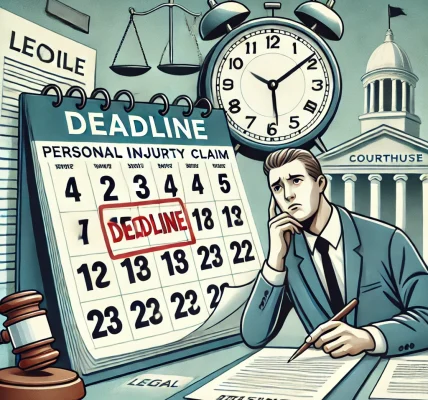Introduction
When people think of personal injury claims, they often focus on physical injuries. However, emotional distress can be just as debilitating as a physical injury. Emotional distress claims allow victims to seek compensation for psychological suffering caused by accidents, negligence, or intentional harm.
In this guide, we will explore the legal basis for emotional distress claims, the evidence required, the challenges involved, and strategies for maximizing compensation.
What is Emotional Distress in Personal Injury Law?
Emotional distress refers to the psychological impact of an injury or traumatic event. It can manifest in various ways, including:
- Anxiety and depression
- Post-traumatic stress disorder (PTSD)
- Insomnia or sleep disturbances
- Phobias or irrational fears
- Loss of enjoyment of life
- Extreme mood swings
Unlike physical injuries, emotional distress is harder to quantify, making claims more complex but still valid under personal injury law.
Types of Emotional Distress Claims
There are two primary types of emotional distress claims in personal injury cases:
1. Negligent Infliction of Emotional Distress (NIED)
This occurs when someone’s negligence causes emotional harm. To succeed in an NIED claim, the plaintiff must typically prove:
- The defendant had a duty of care
- The defendant breached that duty
- The breach caused the plaintiff emotional distress
- The emotional distress was severe and verifiable
Many states require the plaintiff to have suffered a physical injury alongside emotional distress. However, some jurisdictions allow standalone NIED claims if the plaintiff was in the “zone of danger” or witnessed a traumatic event involving a close relative.
2. Intentional Infliction of Emotional Distress (IIED)
IIED claims arise when a defendant’s actions are extreme, outrageous, and intentionally cause severe emotional distress. Unlike NIED, there is no requirement for physical injury. To prove an IIED claim, the plaintiff must demonstrate:
- The defendant’s conduct was extreme and outrageous
- The conduct was intentional or reckless
- It caused severe emotional distress
Examples include severe workplace harassment, extreme bullying, or threats of violence.
Evidence Needed for an Emotional Distress Claim
Since emotional distress is subjective, strong evidence is required to prove its impact. Common forms of evidence include:
1. Medical and Psychological Records
- Diagnosis of PTSD, anxiety, or depression
- Therapy session notes
- Prescription records for medication (e.g., antidepressants, sleep aids)
2. Testimony from Medical Experts
- A psychologist or psychiatrist can provide professional opinions on the severity of emotional distress
3. Personal Journal or Diary
- Keeping a record of emotional struggles, nightmares, panic attacks, or daily challenges can support the claim
4. Witness Statements
- Testimonies from family, friends, or co-workers can confirm behavioral changes
5. Employment Records
- Proof of missed workdays, decreased productivity, or job loss due to emotional distress
How Compensation is Calculated for Emotional Distress
Unlike medical bills or lost wages, emotional distress damages are non-economic, making them harder to calculate. Courts and insurance adjusters consider factors like:
- The severity of distress (mild anxiety vs. debilitating PTSD)
- Duration of suffering (short-term stress vs. lifelong trauma)
- Impact on daily life (difficulty maintaining relationships, job loss)
- Medical evidence (diagnosis from a licensed therapist or psychiatrist)
Common methods for calculating emotional distress damages include:
Multiplier Method
- The total economic damages (medical expenses, lost wages) are multiplied by a number (typically between 1.5 to 5) based on the severity of emotional distress.
Per Diem Method
- A daily dollar amount is assigned to the emotional distress, then multiplied by the number of days the plaintiff suffered.
Challenges in Proving Emotional Distress Claims
Emotional distress claims face several legal hurdles, including:
1. Skepticism from Insurance Companies
- Insurers often argue that emotional distress is exaggerated or unrelated to the incident.
- They may request extensive proof, including medical evaluations.
2. Requirement of Physical Injury (in Some States)
- Many states require a physical injury to accompany emotional distress claims unless the distress is extreme.
3. Difficulty in Valuing Emotional Distress
- Unlike medical bills, there is no fixed price for emotional suffering.
4. The Defendant’s Defense Strategies
- The defendant may argue that the distress was pre-existing or unrelated to their actions.
Tips for Strengthening Your Emotional Distress Claim
1. Seek Medical Help Immediately
- Getting diagnosed and treated by a mental health professional adds credibility to your claim.
2. Keep a Personal Journal
- Document how emotional distress affects your daily life, sleep, work, and relationships.
3. Gather Witness Statements
- Friends, family, or co-workers can provide third-party verification of emotional suffering.
4. Hire an Experienced Personal Injury Attorney
- A lawyer can help present compelling evidence and counteract insurance company tactics.
5. Avoid Social Media Pitfalls
- Insurers may monitor your social media to find evidence that contradicts your claim.
Conclusion
Emotional distress is a serious and valid component of personal injury claims. While these cases can be challenging to prove, the right evidence and legal strategy can lead to fair compensation.
If you believe you have suffered emotional distress due to someone else’s negligence or intentional actions, consult with a personal injury attorney to explore your legal options. By understanding your rights and gathering strong evidence, you can improve your chances of securing the compensation you deserve.




